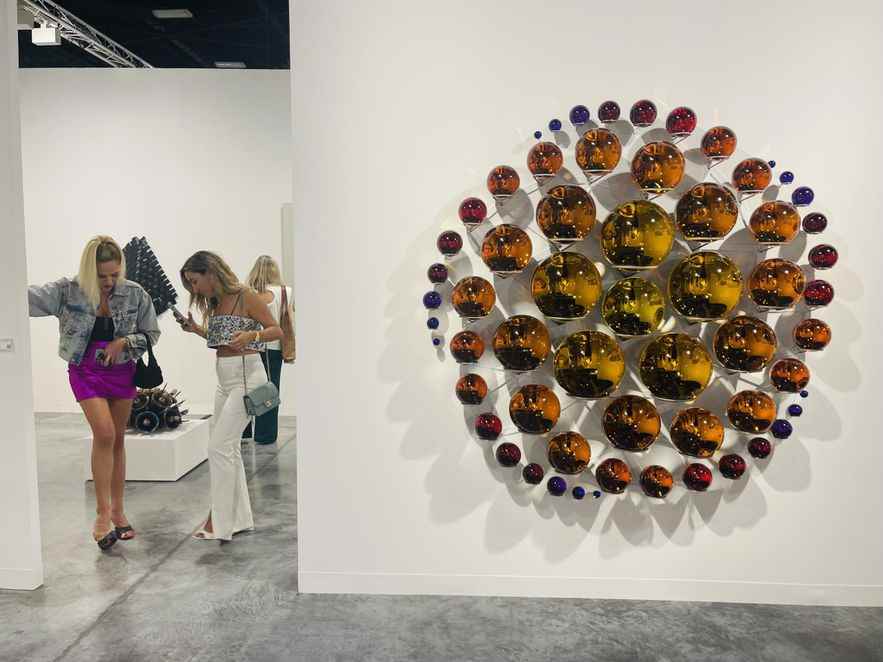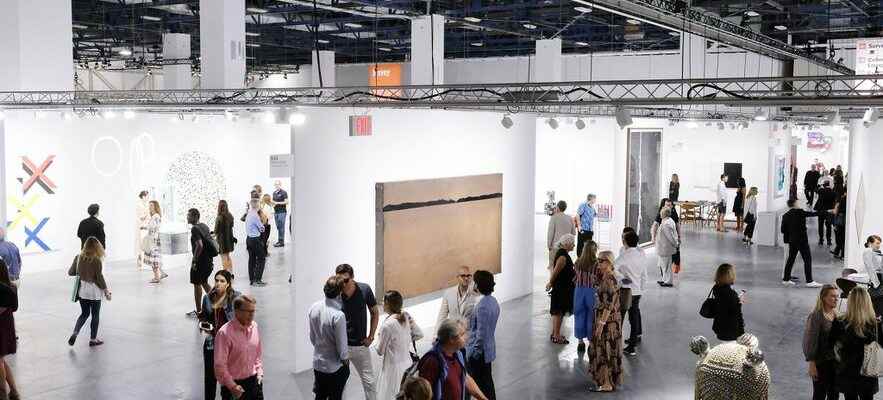Every year, at the end of November-beginning of December, life comes to a standstill in the economic capital of Florida. Suddenly, everything revolves around Art Basel Miami Beach, the international modern and contemporary art fair that is to Miami what carnival is to Rio de Janeiro: a gigantic fiesta where all excess is allowed, as Tom Wolfe tells it. in its fierce and hilarious Bloody Miami (2013).
Everywhere, in villas, on the beach, on the rooftop, in the art galleries, it’s the season for cocktail parties stretching out into the tropical night. During the day, in front of the huge white building of the convention center, it’s effervescence: non-stop, valets welcome collectors who have come (in private jets) from North and South America. Some offer themselves without blinking Carlos Cruz-Diez (1923-2019), the Venezuelan master of kinetic art (containing moving parts), at 350,000 dollars, even Jean-Michel Basquiat (1960-1988) at few millions. The first prices, however, start at 10,000 dollars.
Art Basel contemporary art fair in Miami Beach, Florida was established in 2002
© / afp.com/Nicholas Hunt
“It transformed the DNA of the city”
A subsidiary of Art Basel, created in 1970 in Basel (or Basel, in Swiss German), Art Basel Miami Beach has just celebrated its 20th edition. Since 2002, the cultural and commercial event has established itself, for Miami, as a major instrument of soft-power. “It has transformed the DNA of the city, recognizes the child of the country Dan Gelber, Democratic Mayor of Miami Beach. We are no longer just the city of fun and sun but of something higher, more cultural and more interesting for people of a certain level”, adds, in his office, the sixty-year-old elected official who remembers the time when the city offered nothing else as boxing matches, wrestling or speedboat races.With this annual event, the seaside town has earned respectability alongside Art Basel in Hong Kong (created in 2013) and Paris Plus by Art Basel which, since last year, has taken over from the FIAC at the Grand Palais.
the business model of the event business is simple. “We operate like a real estate agency”, develops, in a private room of the convention center, Marc Spiegler, the “global director” of the Basel company who is about to leave his post after fifteen years of success. “Our business is limited to renting stand locations and providing various services according to the needs of gallery owners, without charging a penny on transactions between them and collectors. 60% of our turnover comes from the rental of location; 30% of partnerships with our sponsors (UBS, Louis Vuitton, Ruinart, etc.); only 10% of ticket sales”, explains the man who has set up a clever two-tier billing system.

a work by Olafur Eliasson at Art Basel Miami 2022
© / AG
“It’s like the progressive tax: the larger the stand, the higher the price per square meter, he explains. The most established galleries on the market pay more than the youngest, which favors the “emergence of new names and maintains a virtuous ecosystem. In return, the “large” galleries have access to the best locations: near champagne bars, on central axes, near entrances.” The system satisfies everyone: 95% of exhibitors return from one year to the next.
In the wake of Art Basel Miami Beach, a dozen other fairs (Design Miami, Nada Miami, Pinta, etc.) were organized during the same period. Florida is also home to more and more art galleries and museums, like the remarkable Norton Museum in Palm Beach (from the 19th to the 21st century). Thanks to the presence of many collectors, the market is highly dynamic. “In Palm Beach, I made the same turnover in five months as in Los Angeles in one year,” says Sarah Gavlak, behind her big pink glasses, who has a gallery in both cities. Further south, in the center of Miami, in a room of the Rubell Museum (contemporary art), we come face to face with a certain Jeff Koons, who is visiting the museum alone. The illustrious kitsch-neo-pop visual artist confirms: “Thanks to families of collectors like the Rubells, Miami has truly become a major cultural crossroads.” If even the world’s most highly rated living artist says so…
